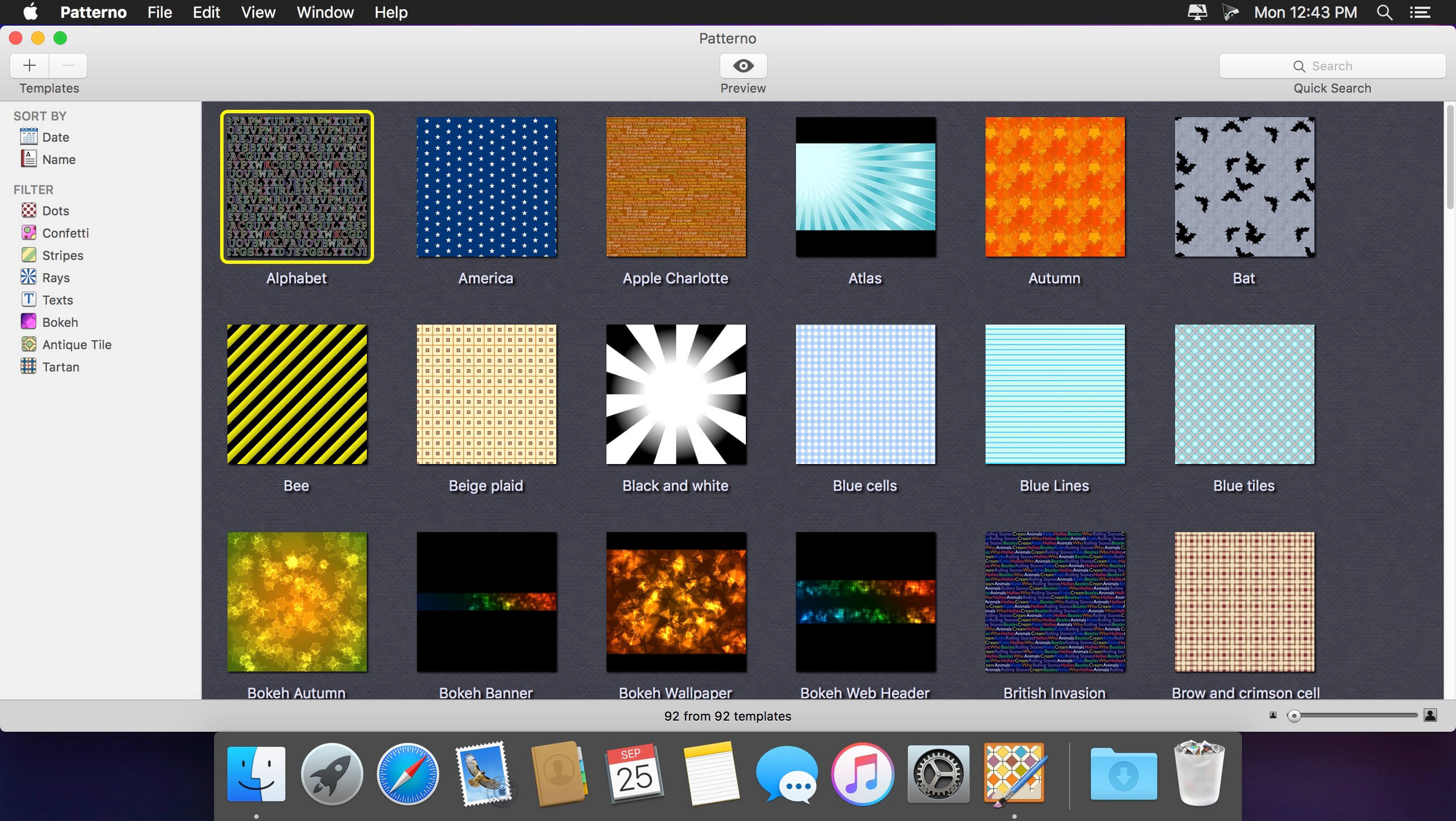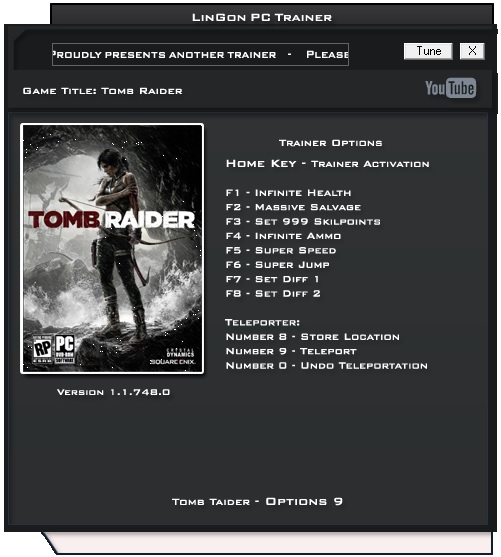Patterno 2.7.1
A pseudorandom binary sequence (PRBS) is a binary sequence that, while generated with a deterministic algorithm, is difficult to predict[1] and exhibits statistical behavior similar to a truly random sequence. PRBS generators are used in telecommunication, but also in encryption, simulation, correlation technique and time-of-flight spectroscopy.
The patterns are the result of three years of planning and discussion by the NCBCA and were developed through the efforts and technical expertise of Kegel's John Janawicz and Vincennes Head Coach Gary Sparks. On October 1, 2017, the NCBCA released two additional sport compliant patterns: 1 medium and 1 short, bringing the total number to 16.
- Translate this node into JVM bytecodes. Patterns are translated as boolean expressions with true/false lists. Before calling translate on a pattern, make sure that the node being matched is on top of the stack.
- Schema Documentation - Schema Version 2.7.1. Document version: 2.7.1 Date: 2015-11-09. This is a draft document. It is intended to support maintenance of CAPEC, and to educate and solicit feedback from a specific technical audience.
- math0,1, 1, 2, 3, 5, 8, 13, 21./math This is called the Fibonacci Sequence. The pattern here is that each term is the sum of the previous 2 terms. (Except for the first 2 terms i.e math0,1/math) It is defined by the linear recurrence rel.
- Apr 24, 2017 In your early days of studying Algebra, lessons deal with both algebraic and geometric sequences. Identifying patterns is also a must in Algebra. When working with fractions, these patterns can be algebraic, geometric or something completely different. The key to noticing these patterns.
Details[edit]
A binary sequence (BS) is a sequence of bits, i.e.
- for .
A BS consists of ones and zeros.
A BS is a pseudorandom binary sequence (PRBS) if[2] its autocorrelation function, given by
Pattern 2.7.1 File
has only two values:
where
is called the duty cycle of the PRBS, similar to the duty cycle of a continuous time signal. For a maximum length sequence, where , the duty cycle is 1/2.
A PRBS is 'pseudorandom', because, although it is in fact deterministic, it seems to be random in a sense that the value of an element is independent of the values of any of the other elements, similar to real random sequences.
A PRBS can be stretched to infinity by repeating it after elements, but it will then be cyclical and thus non-random. In contrast, truly random sequence sources, such as sequences generated by radioactive decay or by white noise, are infinite (no pre-determined end or cycle-period). However, as a result of this predictability, PRBS signals can be used as reproducible patterns (for example, signals used in testing telecommunications signal paths).[3]
Practical implementation[edit]
Pseudorandom binary sequences can be generated using linear-feedback shift registers.[4]
Some common[5][6][7][8][9] sequence generating monic polynomials are
- PRBS7 =
- PRBS9 =
Pattern 2.7.1 1
- PRBS11 =
- PRBS15 =
- PRBS20 =
- PRBS23 =
- PRBS31 =
An example of generating a 'PRBS-7' sequence can be expressed in C as
In this particular case, 'PRBS-7' has a repetition period of 127 bits.
Pattern 2.7.1 Software
Notation[edit]
The PRBSk or PRBS-k notation (such as 'PRBS7' or 'PRBS-7') gives an indication of the size of the sequence. is the maximum number[3]:§3 of bits that be in the sequence. The k indicates the size of a unique word of data in the sequence. If you segment the N bits of data into every possible word of length k, you will be able to list every possible combination of 0s and 1s for a k-bit binary word, with the exception of the all-0s word.[3]:§2 For example, PRBS3 = '1011100' could be generated from .[5] If you take every sequential group of three bit words in the PRBS3 sequence (wrapping around to the beginning for the last few three-bit words), you will find the following 7 word arrangements:
Those 7 words are all of the possible non-zero 3-bit binary words, not in numeric order. The same holds true for any PRBSk, not just PRBS3.[3]:§2
See also[edit]
References[edit]
- ^'PRBS Pseudo Random Bit Sequence Generation'. TTi. Retrieved 21 January 2016.
- ^Naszodi, Laszlo. 'Articles on Correlation and Calibration'. Archived from the original on 11 November 2013.
- ^ abcd'ITU-T Recommendation O.150'. October 1992.
- ^Paul H. Bardell, William H. McAnney, and Jacob Savir, 'Built-In Test for VLSI: Pseudorandom Techniques', John Wiley & Sons, New York, 1987.
- ^ abTomlinson, Kurt (4 February 2015). 'PRBS (Pseudo-Random Binary Sequence)'. Bloopist. Retrieved 21 January 2016.
- ^Koopman, Philip. 'Maximal Length LFSR Feedback Terms'. Retrieved 21 January 2016.
- ^'What are the PRBS7, PRBS15, PRBS23, and PRBS31 polynomials used in the Altera Transceiver Toolkit?'. Altera. 14 February 2013. Retrieved 21 January 2016.
- ^Riccardi, Daniele; Novellini, Paolo (10 January 2011). 'An Attribute-Programmable PRBS Generator and Checker (XAP884)'(PDF). Xilinx. Table 3:Configuration for PRBS Polynomials Most Used to Test Serial Lines. Retrieved 21 January 2016.
- ^'O.150 : General requirements for instrumentation for performance measurements on digital transmission equipment'. 1997-01-06.
External links[edit]

- OEISsequence A011686 (A binary m-sequence: expansion of reciprocal) -- the bit sequence for PRBS7 =
This is a set of macros and a dialog which allows the appearance of Hatch patterns within cells.
Project Description
This is a set of macros and a dialog which allows the appearance of Hatch patterns within cells.
Release Details
LibreOffice has 10 predefined hatch patterns which can be applied to graphic objects. This extension creates an image the same shape and dimension as the chosen cell. Using the coordinates of the cell corner, the pattern is placed on the Draw Page so the cell appears to contain a hatch pattern.
Patterns can be applied, deleted or changed by selecting the cells to be affected, starting the dialog and choosing the options.
New patterns may also be utilized.
Category/Categories
Calc Extension,
Current Release
Hatch Patterns for Cells - 1.2.1
Released Mar 08, 2018 — tested with:
LibreOffice 4.4, LibreOffice 5.0, LibreOffice 5.1, LibreOffice 5.2, LibreOffice 5.3, LibreOffice 5.4, LibreOffice 6.0,
There are no functional changes in this version.Off-line help is now included if you have the LibreOffice off-line help installed. Itwill be located on the Contents tab.
More about this release…
Paterno 2 7 11
CalcHatchCells-L-1.2.1.oxtAll Releases
Version | Released | Platform(s) | Compatibility | Description | License(s) | Status |
1.2.1 | Mar 08, 2018 |
|
| There are no functional changes in this version.Off-line help is now included if you have the LibreOffice off-line help installed. Itwill be located on the Contents tab. |
| final |
Legal Disclaimer and Limitations for Downloads
The Document Foundation has not reviewed, and cannot review, all of the material, including computer software, available on or by means of The Document Foundation's
websites, and cannot therefore be responsible for that material's content, use or effects. By operating its websites, The Document Foundation does not represent or imply that it endorses the material there available, or that it believes such material to be accurate, useful or nonharmful. You are responsible for taking precautions as necessary to protect yourself and your computer systems from viruses, worms, Trojan horses and other harmful or destructive content. The Document Foundation's websites may contain content that is offensive, indecent or otherwise objectionable, as well as content containing technical inaccuracies, typographical mistakes and other errors. The Document Foundation's websites may also contain material that violates the privacy or publicity rights, or infringes the proprietary rights, of third parties, or the downloading, copying or use of which is subject to additional terms and conditions, stated or unstated. The Document Foundation disclaims any responsibility for any harm resulting from the use by The Document Foundation's visitors of The Document Foundation's websites, or from any downloading by those visitors of content available on or by means of The Document Foundation's websites.
Changes

Content contained on The Document Foundation's websites, including these Legal Disclaimers and Limitations, may be changed at the sole discretion of The Document Foundation and without notice. You are bound by any such updates or changes, and so should periodically review these Legal Disclaimers and Limitations.
If you believe any file is present on the site contrary to any TDF rule or applicable law, please supply full details to info@documentfoundation.org for impartial consideration.
